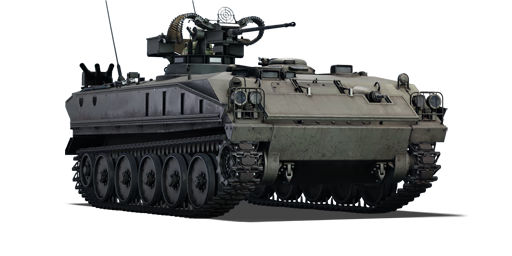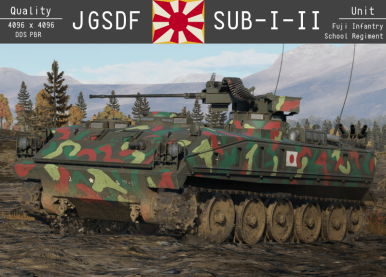

Ground Vehicles
SUB-I-II
IV
Rank
AB
5.3
RB
5.3
SB
5.3
Battle rating
Japan
Research country
SPAA
Main role
46,000

Research
155,000

Purchase
General information
The SUB-I-II was a prototype for the Type 73 APC meant to replace the smaller Type 60 APC. Going through multiple prototypes, this particular version was tested with a Rh202 (20 mm) as a self-defense and anti-air cannon, though this armament would not see use in the final version.
It was introduced in Update "Apex Predators". The SUB-I-II provides an excellent fire rate with the possibility of an APDS belt in an amphibious yet squishy APC hull only offering up to 20 mm of armour. As such, if positioned correctly against a suitable target, the SUB-I-II can utilize the APDS autocannon to shred their opponent apart.
Camouflages
Survivability and armour
Armour
front / side / back
Hull
20 / 12 / 20 mm
Turret
20 / 20 / 20 mm
Visibility
88 %
Crew
4 persons
Support systems
Mobility
Max speed
Forward
6065 km/h
Backward
1516 km/h
Power-to-weight ratio
25.92345.336.8 hp/t
Engine power
350310612497 hp
Weight
13.5 t
Optics
Gunner
Commander
Driver
Optics zoom
1.9x–3.5x
—
—
Armaments
20 mm Rh202 cannon
Ammunition
800 rounds
Belt capacity
100 rounds
Reload
basic crew → aces
10.4 → 8 s
Fire rate
1,030 shots/min
Vertical guidance
-10 / 80°
Turret Rotation Speed
basic crew → aces
Horizontal
4235.773.152.8 → 6051104.575.5 °/s
Vertical
1411.242.727.3 → 20166139 °/s
| Belt | Belt filling | Armor penetration (mm) at a distance: | |||||
|---|---|---|---|---|---|---|---|
| 10 m | 100 m | 500 m | 1000 m | 1500 m | 2000 m | ||
| HVAP-T/HEFI-T | 57 | 52 | 37 | 24 | 15 | 10 | |
| HEFI-T/HEFI-T/HEFI-T/HVAP-T | 57 | 52 | 37 | 24 | 15 | 10 | |
| HVAP-T/HVAP-T/HVAP-T/HEFI-T | 57 | 52 | 37 | 24 | 15 | 10 | |
| APDS/APDS/APDS/HEFI-T | 66 | 61 | 45 | 31 | 21 | 14 | |
7.62 mm M1919A4 machine gun
Ammunition
1,000 rounds
Belt capacity
250 rounds
Reload
basic crew → aces
10.4 → 8 s
Fire rate
500 shots/min
Vertical guidance
-10 / 10°
Horizontal guidance
-10 / 10°
Turret Rotation Speed
basic crew → aces
Horizontal
1411.924.417.6 → 201734.825.2 °/s
Vertical
1411.242.727.3 → 20166139 °/s
| Belt | Belt filling | Armor penetration (mm) at a distance: | |||||
|---|---|---|---|---|---|---|---|
| 10 m | 100 m | 500 m | 1000 m | 1500 m | 2000 m | ||
| AP/T | 13 | 12 | 7 | 3 | 2 | 0 | |
Economy
Repair cost
Basic → Reference
AB
2,794 → 3,780 

RB
2,217 → 3,000 

SB
3,429 → 4,639 

Crew training
45,000 

Experts
155,000 

Aces
630 

Research Aces
440,000 

Reward multiplier
AB / RB / SB
110 / 140 / 200 % 

160 % 

Total cost of modifications
40,400 

78,000 

Talisman cost
1,400 

Mobility | |
|---|---|
Protection |
|---|
Firepower | |
|---|---|
Rating by players
You must play more than 3 battles for the last week and more than 10 battles in a vehicle to rate it.
Like:
20
Armor protection:
Not enough ratings
Survivability:
Not enough ratings
Mobility:
Not enough ratings
Armament:
Not enough ratings
Balance:
Not enough ratings
Tips & Tricks
This space is currently empty
Do you know any interesting vehicle features?
Loading...
No articles about this vehicle yet
Become the first author and get rewards!
Write a guide, tell about interesting historical facts, make a tutorial or simply an interesting post.
No more content
